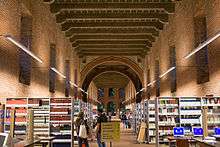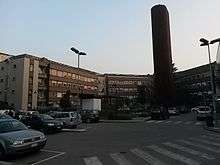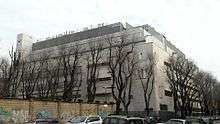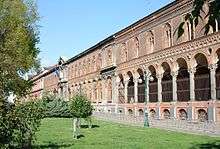University of Milan
The University of Milan (Italian: Università degli Studi di Milano, Latin: Universitas Studiorum Mediolanensis), known colloquially as UniMi or Statale, is a higher education institution in Milan, Italy. It is one of the largest universities in Europe, with about 60,000 students,[5] and a permanent teaching and research staff of about 2,000.[6]
Università degli Studi di Milano | ||
 Seal of the University of Milan | ||
| Latin: Universitas Studiorum Mediolanensis | ||
| Motto | Scientia illuminans dignus | |
|---|---|---|
Motto in English | Knowledge enlightening the worthy | |
| Type | Public | |
| Established | 1924 | |
| Budget | €467 million (2020) | |
| Rector | Prof. Elio Franzini[1] | |
Academic staff | 2100 (2018) [2] | |
Administrative staff | 1,872 (2017)[3] | |
| Students | 61,547 (2018/19) [4] | |
| Undergraduates | 36,717 | |
| Postgraduates | 23,058 | |
| 869 | ||
Other students | 903 | |
| Location | , Italy | |
| Campus | Urban | |
| Colours | Milan blue
| |
| Athletics | CUS Milano | |
| Nickname | UNIMI | |
| Affiliations | EUA LERU | |
| Website | www | |
The University of Milan has ten schools and offers 140 undergraduate and graduate degree programmes, 32 Doctoral Schools and 65+ Specialization Schools. The University's research and teaching activities have grown over the years and have received important international recognitions.
The University is the only Italian member of the League of European Research Universities (LERU), a group of twenty-one research-intensive European Universities. It consistently ranks one of the best universities of Italy, both overall and in specific subject areas.
One Nobel laureate in physics, Riccardo Giacconi,[7] as well as one Fields medalist, Enrico Bombieri,[8] studied at the University.
Academics

The University of Milan is a public teaching and research university, which – with nine schools and a teaching staff of about 2,200 – comprises a wide variety of disciplinary fields.
Schools


The University comprises 10 Schools (facoltà):
- School of Law
- School of Medicine
- School of Humanities
- School of Veterinary Medicine
- School of Agricultural and Food Sciences
- School of Pharmaceutical Sciences
- School of Science and Technology
- School of Exercise and Sport Sciences
- School of Political, Economic and Social Sciences
- School of Linguistics and Cultural Mediation
Research
Research is organized in 33 departments. There were 8,453 publications in 2019. There are 53 research centres.
Campuses

The University of Milan possesses an important artistic and cultural heritage that includes important historic buildings, inherited and acquired collections, archives, botanical gardens and the old Brera Astronomical Observatory commissioned by Maria Theresa of Austria.[9] The University's departments are housed in important historic buildings in the centre of Milan and in modern buildings in the area known as Città Studi (City of Studies). Among the palazzos that house the University's facilities are the old "Ca’ Granda" ("the big house"), a monumental complex from the 15th century in the heart of the historical city centre; the 18th-century Palazzo Greppi designed by Giuseppe Piermarini (architect of La Scala in Milan) and the 17th-century Sant’Alessandro College commissioned by the Arcimboldi family. The book collection, which is one of the richest in the region, is preserved in 47 libraries,[10] while the APICE Centre collects rare and valuable book stocks and archives.
The total university surface area is about 500,000 m2 (5,400,000 sq ft), comprising 356 classrooms with approximately 27,382 seats, 203 teaching and computer laboratories with approximately 1,831 seats and 171 libraries and study rooms with approximately 4,417 seats.
Rankings
| University rankings | |
|---|---|
| Global – Overall | |
| ARWU World[11] | 151–200 (2018) |
| THE World[12] | 301–350 (2018) |
| USNWR Global[13] | 158 (2018) |
| QS World[14] | 325 (2018) |
The University of Milan is the only Italian member of the League of European Research Universities (LERU), a group of twenty-one research-intensive European Universities, which it helped found.[15][16]
The university consistently ranks as Italy's best university in a number of areas. In the most recent ranking of Italian universities released by ANVUR in February 2017, Statale ranked first among Italian universities in the areas of political science, sociology, law, and philosophy.[17] It also ranked among the top three in economics and statistics, earth science, history, and antiquities.[18]
The university is ranked third in Italy by Center for World University Rankings (CWUR)[19] and fourth in the Webometrics Ranking of World Universities.[20] It is ranked first in Italy (five-way tie) by the Academic Ranking of World Universities while the Times Higher Education World University Rankings[21] ranks it 6th to 9th (tied with four other universities).
History



Early years
The University of Milan was founded in 1924 from the merger of two institutions that boasted a great tradition of medical, scientific and humanistic studies: the Accademia Scientifico-Letteraria (Scientific-Literary Academy), active since 1861, and the Istituti Clinici di Perfezionamento (Clinical Specialisation Institutes), established in 1906. By 1928, the University already had the fourth-highest number of enrolled students in Italy, after the University of Naples, Sapienza University of Rome and the University of Padua. Its premises are located in Città Studi (the City of Studies), the university district built from 1915 onwards (that is also home to the Politecnico di Milano), where scientific schools have its headquarters, and in several buildings in the historic city centre, which house the humanities schools.[22]
At the time of its foundation, there were four "traditional" schools – Law, Humanities, Medicine and Mathematical, Physical and Natural Sciences; then, in the 1930s, the Schools of Veterinary Medicine and Agriculture were introduced, after the aggregation of the old schools of Veterinary Medicine (1792) and Agriculture (1871).
At the end of the Second World War, the old Ospedale dei Poveri (Hospital for the Poor) building, known as "la Cà Granda" (the Big House), was assigned to the University. The building, one of the first Italian examples of civil architecture – commissioned in the 15th century by the Sforza family, the dukes of Milan – was seriously damaged by the bombings of 1943. In 1958, after a complex series of reconstruction and renovation works, it became home to the University Rector's Office, the administrative offices and the schools of Law and Humanities.
1960s reformation
In the 1960s, due to the extension of compulsory school attendance and the subsequent liberalisation of access to higher education, the number of people entering Italian universities progressively increased and the University of Milan enrolled more than 60,000 students. The University added to its range of courses and at the same time increased its number of centres. Two new schools were established, Pharmacy and Social and Political Sciences, which were based, respectively, in Città Studi and in Via Conservatorio, in Milan city centre.
Città Studi was also the site of a new complex, intended entirely for the biology departments, which was the work of architect Vico Magistretti. There was also an increase in the number of agreements with the city's hospital facilities, where students from the School of Medicine receive their clinical training. In 1968, the University was occupying approximately 127,000 m2 (1,370,000 sq ft); by the beginning of the 1980s this had increased to 205,000 m2 (2,210,000 sq ft). In 1989 there were 22 degree courses and 75,000 enrolled students, which increased to 90,000 by 1993.
1980s streamline process
In view of this increase, the University began a process of streamlining and delocalising its facilities: from 1986 onwards, new centres began to appear in other areas of Milan, particularly in the Bicocca district, as well as in other parts of the region: in Como, Varese, Crema and Lodi.
In 1998, the University split in two and the city's second public institution was founded: The University of Milan-Bicocca. The University of Insubria was also established in Varese, bringing together courses that were already offered at Varese and Como by the Universities of Milan and Pavia. At the conclusion of this process, notwithstanding the reduction in the number of students, the University of Milan was still the largest institution in Lombardy and still one of the largest in the country.
The 2001 law that transformed the education system opened a new phase of change. The University updated its range of courses, trying to adapt them to better suit the evolution of the social demand for education and the innovation of the production system: thus, the number of degree courses rose to 74 and there was a new increase in enrolments. There was also an increase in the University's commitment to providing student services (orientation, internships and training, online education) and in investments for new education and research facilities, covering approximately 80,000 m2 (860,000 sq ft).
The most recent phase of expansion concerned the fields of communication science, intercultural mediation and art, but there are also ongoing projects relating to the sectors of information technology, veterinary medicine and biomedicine. Furthermore, there was also a strengthening of commitment to technology transfer and the practical application of scientific research results in the economic-production context.
Present
At the present time, the University comprises 9 schools, 134 study courses (both undergraduate and graduate), 19 doctoral schools (scuole di dottorato) and 92 specialisation schools (scuole di specializzazione). Approximately 65,000 students are enrolled at the University. The teaching staff is composed of 2,500 tenured professors and researchers and approximately 500 adjunct professors. More than 2,300 people work in the technical and administrative sector. The University of Milan was one of the institutions that helped to found LERU, the League of European Research Universities, and is the only Italian University to be a member of the organisation. Thanks to its commitment to basic and applied research, the University is among the top institutions in the main national and international rankings.[23]
Budget
In 2010, income – excluding special accounting and clearing entries – amounted to €562 million, primarily from:
- State: €331 million for normal running costs
- Students: €91 million in the form of fees and contributions
- Public and private institutions: €59 million for research activities
Sports, arts and entertainment
Sporting activities
Centro Universitario Sportivo (CUS), University Sports Centre, is an amateur sports association which, for the last 60 years, has promoted the practice of physical education and sport by students and university collaborators. Every year, the centre organises a vast range of sports courses, which cover everything from traditional disciplines, such as swimming and athletics, to more modern activities, such as hydro-biking, yoga and capoeira.
Arts and entertainment
University of Milan students can take part in music and theatre initiatives organised by the University's resident cultural institutions, which include the Orchestra, the Choir and the CUT, the University Theatre Centre. The University of Milan Orchestra offers students the possibility to audition for a classical music ensemble in collaboration with the "Giuseppe Verdi" Conservatory of Milan and with the direction of Maestro Alessandro Crudele.
The University Choir is composed of university staff, students, professors and enthusiasts from outside the university. It is possible to become a member by passing an audition.
The Centro Universitario Teatrale (CUT), University Theatre Centre, is currently directed by Professor Alberto Bentoglio and collaborates actively with groups of university students who have been involved in theatre productions for several years.
Concessions for cultural activities
The University works closely with cinema, theatre, dance and music agents, to provide their students and collaborators with access to cultural initiatives and services at reduced prices.
See also
| Wikimedia Commons has media related to Università Statale (Milan). |
References
- The Rector: Elio Franzini
- Facts and Figures
- Piano dei fabbisogni e Carichi di Lavoro
- Student data
- "Student data".
- "Research Facts and Figures".
- "Riccardo Giacconi biography".
- "Enrico Bombieri biography".
- Antonello, E. (2014). "Bonaparte and the astronomers of Brera Observatory". arXiv:1405.6841 [physics.hist-ph].
- "Servizio Bibliotecario d'Ateneo - Home".
- Academic Ranking of World Universities 2018
- World University Rankings 2018
- U.S. News Education: Best Global Universities 2018
- QS World University Rankings 2018
- "The Rectors of the LERU Universities gather in Milan - Università degli Studi di Milano". www.unimi.it. Retrieved 26 April 2019.
- "Members". LERU. Retrieved 26 April 2019.
- "Qualità della ricerca, il rapporto Anvur incorona Padova". Repubblica.it (in Italian). 21 February 2017. Retrieved 3 March 2017.
- Riva, Gianna Fregonara e Orsola. "Da Padova a Milano, la ricerca al top Guarda la classifica dell'Anvur L'Italia cresce più di Parigi e Berlino". Corriere della Sera (in Italian). Retrieved 3 March 2017.
- "CWUR 2016 | Top Universities in Italy". cwur.org. Retrieved 3 March 2017.
- "European Union | Ranking Web of Universities". www.webometrics.info. Retrieved 3 March 2017.
- "Best universities in Italy". Times Higher Education (THE). 3 January 2017. Retrieved 3 March 2017.
- "History and Heritage - University of Milan". www.unimi.it. Retrieved 26 April 2019.
- "University of Milan". Times Higher Education (THE). 25 March 2019. Retrieved 26 April 2019.
External links
- University of Milan Website (in English)
- Università degli Studi di MIlano (in Italian)